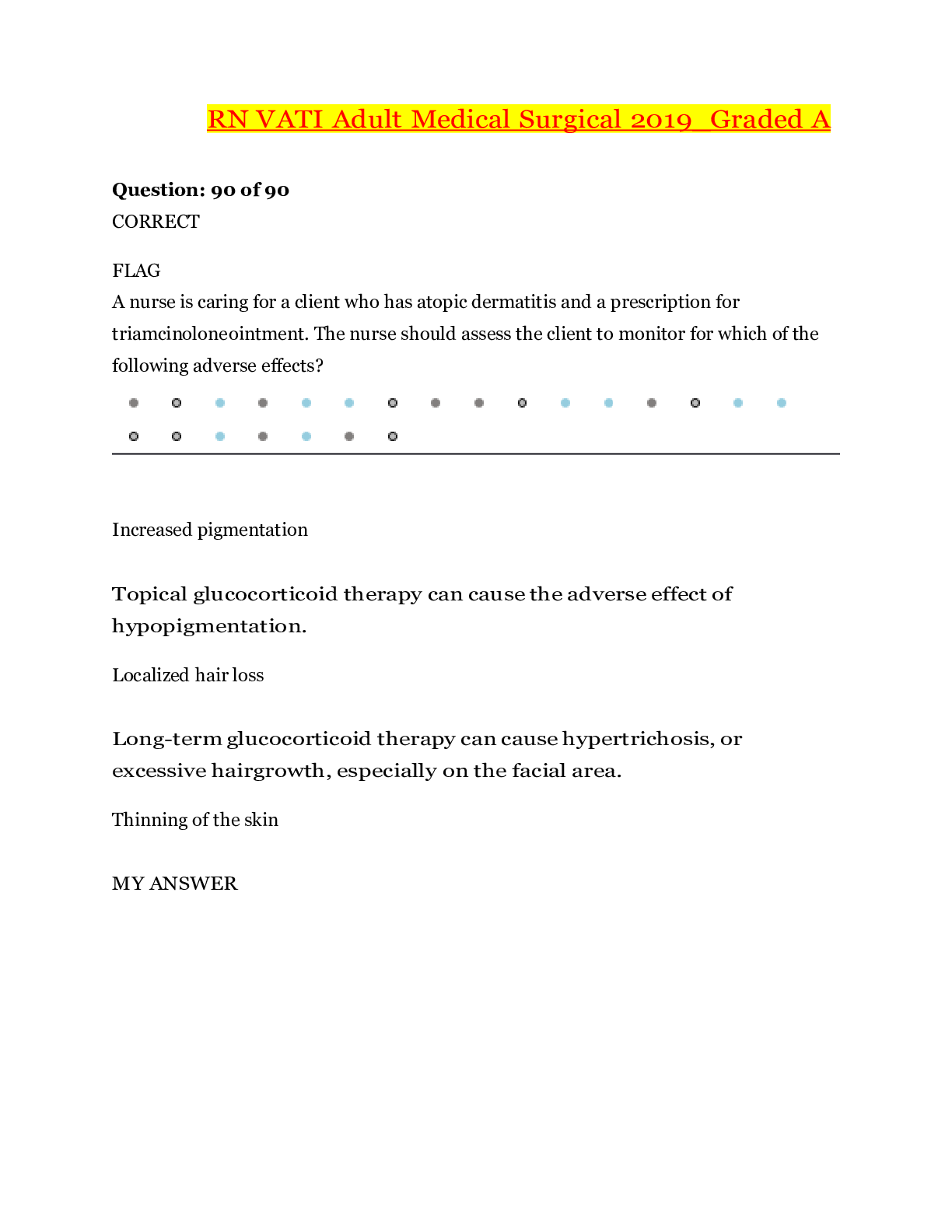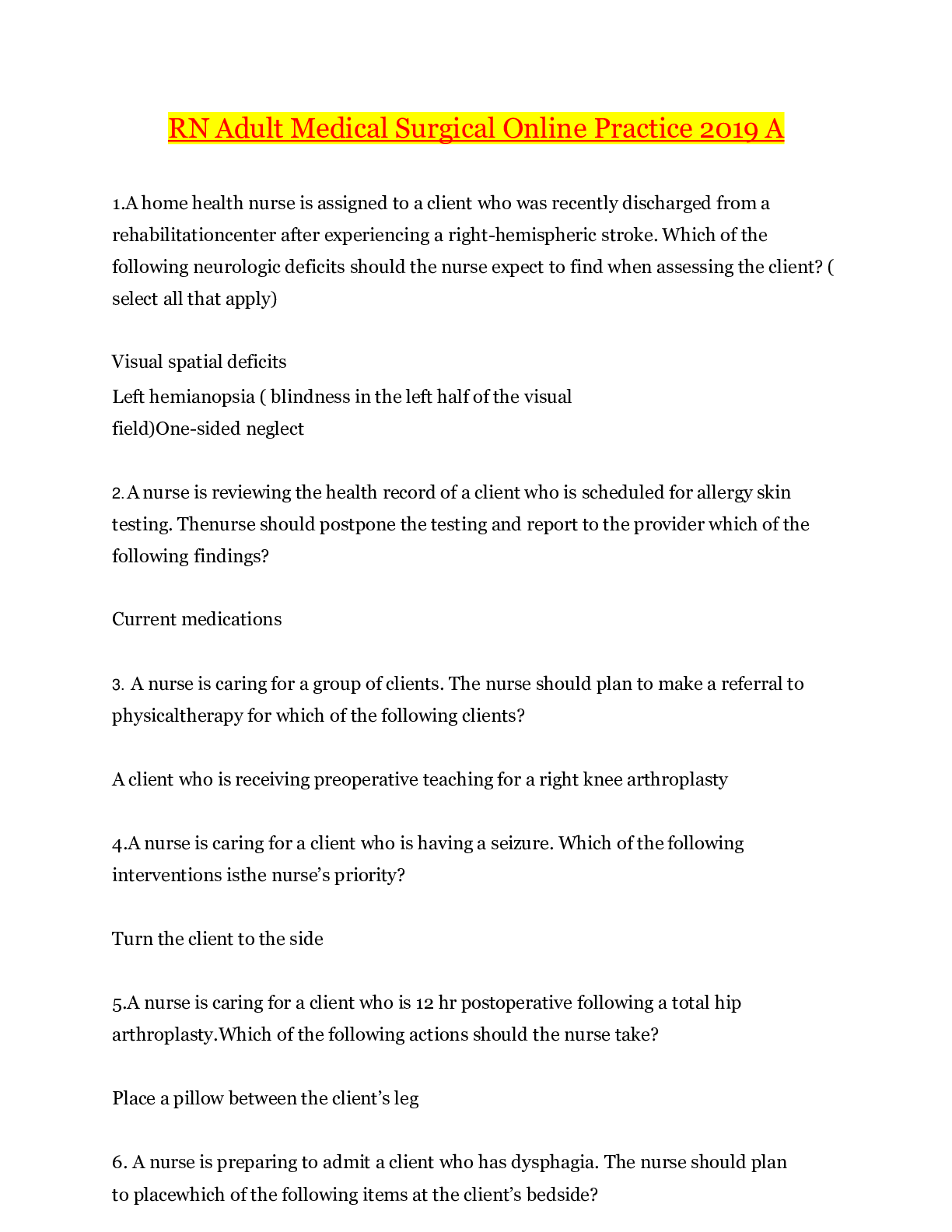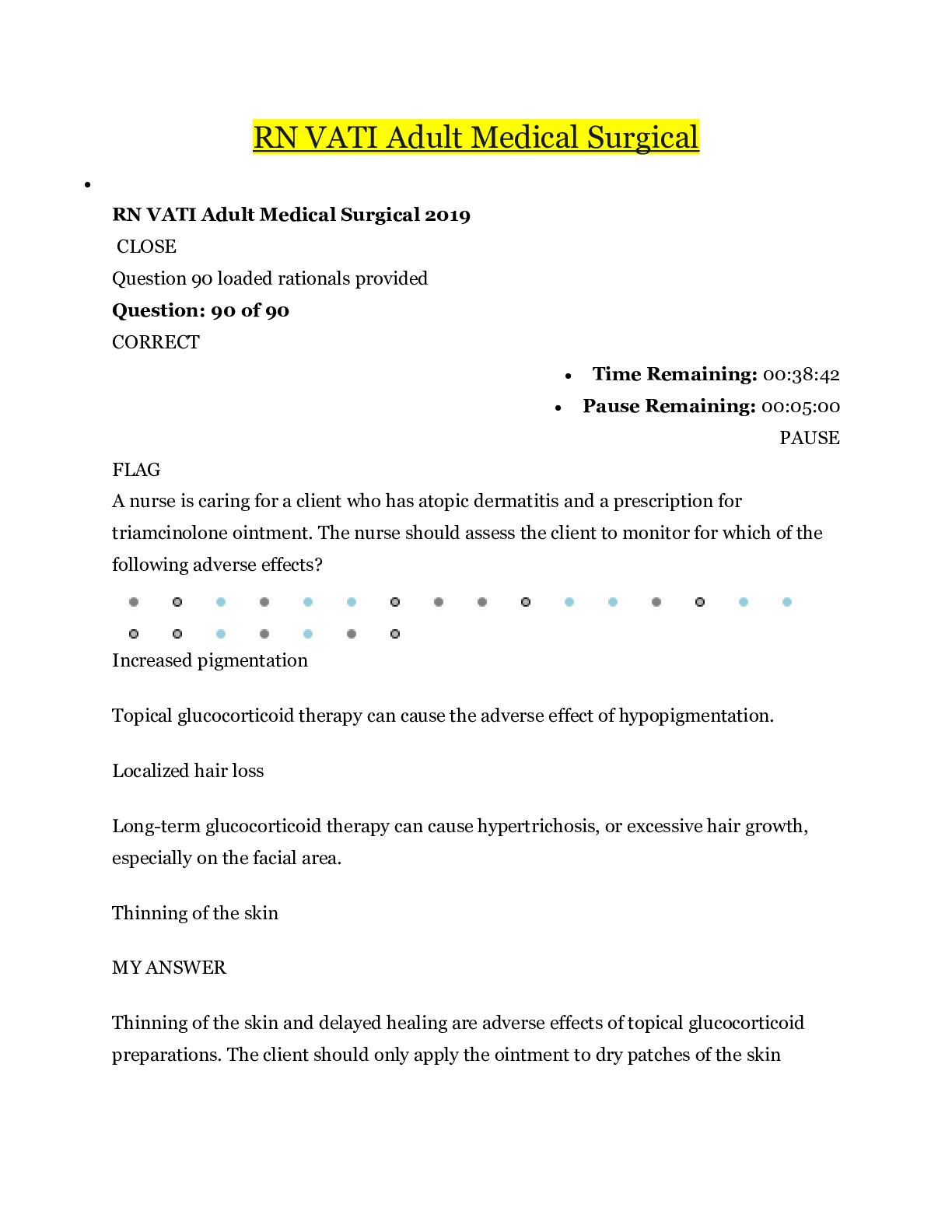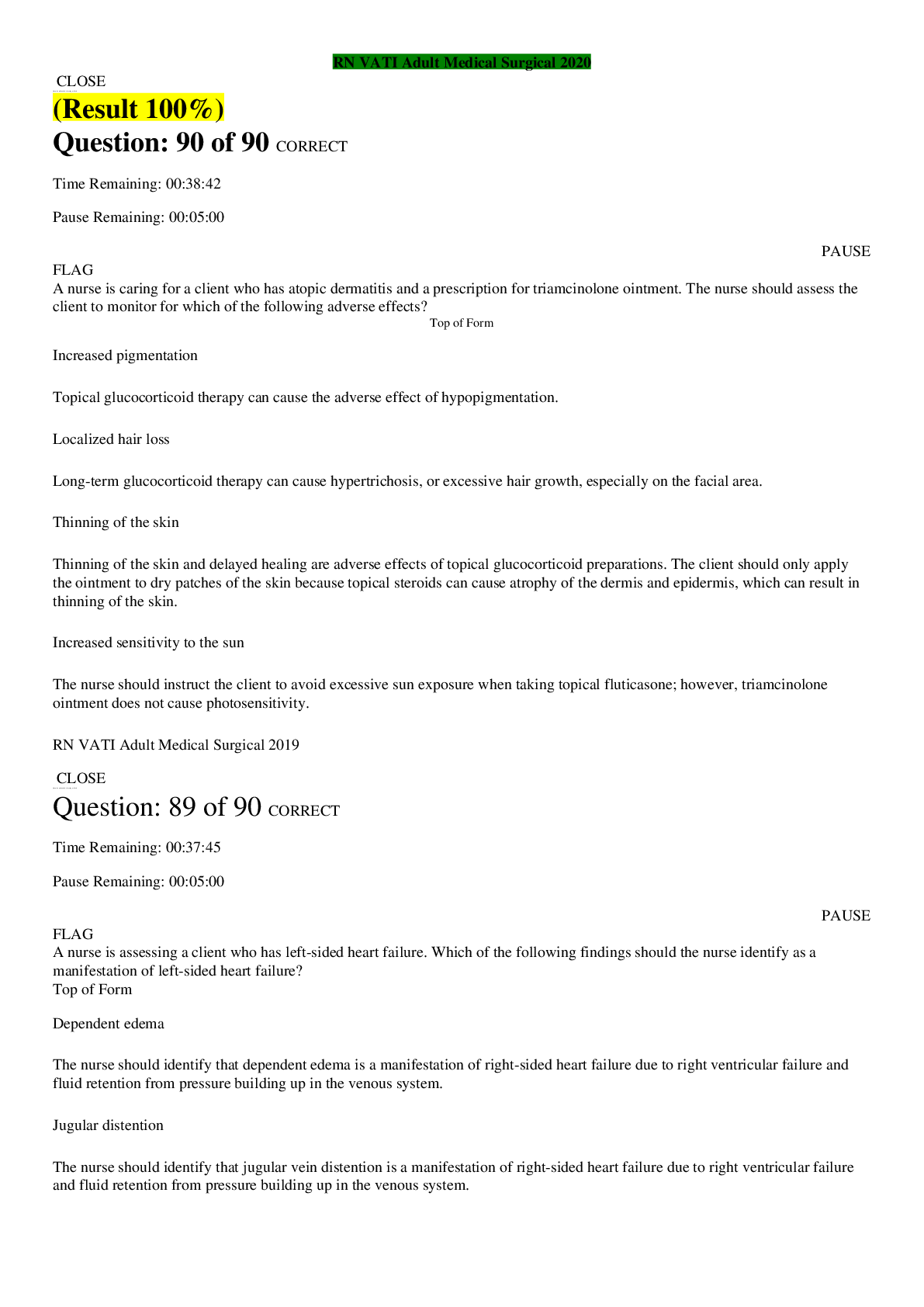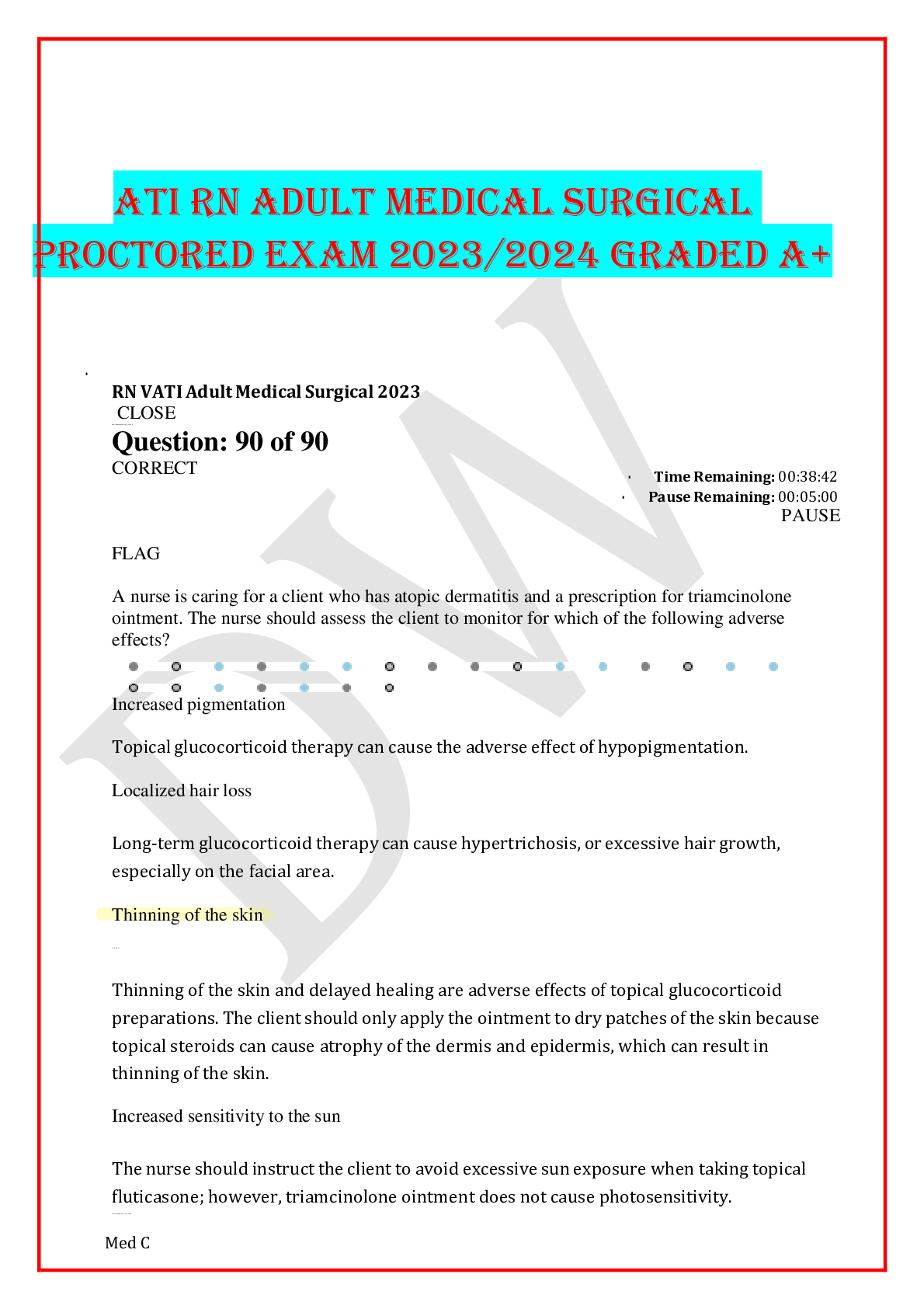RN VATI Adult Medical Surgical 2021: all questions answered correctly
Document Content and Description Below
RN VATI Adult Medical Surgical (answered)2021 A nurse is caring for a client who has atopic dermatitis and a prescription for triamcinolone ointment. The nurse should assess the client to monitor for ... which of the following adverse effects? A nurse is assessing a client who has left-sided heart failure. Which of the following findings should the nurse identify as a manifestation of left-sided heart failure? A nurse is caring for a client who is experiencing anxiety as well as numbness and tingling of the lips and fingers. The client's ABGs are: pH 7.48, PCO2 30 mm Hg, HCO3- 24 mEq/L, PaO2 85 mm Hg. Which of the following acid-base imbalances should the nurse identify that the client is experiencing? A nurse is assessing a client who has Cushing's syndrome. Which of the following findings should the nurse expect? A nurse is inspecting the skin of a client who has basal cell carcinoma. The nurse should identify which of the following lesion characteristics on the client's skin? A nurse is assessing a client who has hypocalcemia. In which of the following areas should the nurse tap on the client's face to detect the presence of Chvostek's sign? (You will find hot spots to select in the artwork below. Select only the hot spot that corresponds to your answer.) A nurse in an emergency department is assessing a client who is overusing prescribed diuretics and has a sodium level of 127 mEq/L. Which of the following laboratory findings should the nurse expect? A home health nurse is assisting a client with planning care for a family member who has Alzheimer's disease. Which of the following instructions should the nurse include? A nurse is caring for a client who has developed acute respiratory distress syndrome (ARDS). Which of the following findings should the nurse identify as a manifestation of this syndrome? An emergency room nurse is assessing a client who has asthma and difficulty breathing. Which of the following findings should indicate to the nurse that the client is experiencing status asthmaticus? A nurse is teaching a client who has a new prescription for phenytoin to treat a seizure disorder. Which of the following adverse effects should the nurse instruct the client to report immediately to the provider? A nurse is monitoring a client following a lumbar laminectomy. The client has a drain and indwelling urinary catheter. The nurse should identify which of the following findings as an indication of a complication of the surgery? A nurse is assessing a client who has right-sided heart failure. Which of the following findings should the nurse identify as a manifestation of right-sided heart failure? A nurse is caring for a client who recently assumed the role of caregiver for their aging parents who have chronic illnesses. The nurse should identify that which of the following statements by the client indicates acceptance of the role change? "I changed the floor plan of our home to accommodate my father's wheelchair." A nurse is caring for a client who is receiving vancomycin intermittent IV bolus therapy for methicillin-resistant Staphylococcus aureus (MRSA). Which of the following findings is an indication to the nurse that the client is experiencing an adverse effect of the medication? A nurse is caring for a male client who has a new prescription for cyclosporine following a kidney transplant. Which of the following findings should the nurse identify as an adverse effect of this therapy? A nurse is caring for a client who has dumping syndrome following a gastric resection. The nurse should monitor the client for which of the following complications of dumping syndrome? A nurse is assessing a client who takes salmeterol to treat moderate asthma. Which of the following findings should indicate to the nurse that the medication has been effective? A nurse is providing teaching about health promotion activities for a client who has a new diagnosis of type 1 diabetes mellitus. Which of the following statements by the client indicates an understanding of the teaching? A nurse is providing teaching to a client who has a new prescription for warfarin. Which of the following medications should the nurse instruct the client to avoid? (Select all that apply.) Naproxen is correct. Naproxen is an NSAID that relieves mild to moderate pain. It can increase the risk of bleeding if taken with warfarin. A nurse is providing discharge teaching about infection control at home for a client who has tuberculosis. Which of the following statements by the client indicates an understanding of the teaching? A nurse is teaching a client who is scheduled to receive radioactive iodine therapy for treatment of hyperthyroidism. Which of the following instructions should the nurse include in the teaching? A nurse is providing preoperative teaching to a client who is scheduled for a radical prostatectomy. Which of the following information should the nurse include in the teaching? A nurse is assessing a client's ECG strip and notes an irregular heart rate of 98/min with no clear P waves. Which of the following cardiac dysrhythmias should the nurse document? A nurse is caring for a client who is receiving peritoneal dialysis. Which of the following actions should the nurse take? A nurse is assessing a client who has suspected appendicitis. Which of the following manifestations should the nurse expect? (Select all that apply.) Elevated WBC count is correct. A client who has acute appendicitis will show a moderate elevation of the WBC count from 10,000 to 18,000/mm3. If the WBC count is greater than 20,000/mm3, it can indicate a perforated appendix. Elevated amylase level is incorrect. Amylase levels increase with pancreatitis but not with acute appendicitis. A nurse is planning preventative strategies for a client who is at risk for pressure injuries. Which of the following actions should the nurse include in the plan? A nurse is caring for a client who has a new diagnosis of type 1 diabetes mellitus. Which of the following findings should the nurse identify as a manifestation of type 1 diabetes? A nurse is caring for a client who had a surgical repair of an abdominal aortic aneurysm 3 days ago. The client's vital signs are: temperature 38.3° C (100.9° F), heart rate 80/min, respirations 16/min, and blood pressure 128/76 mm Hg. Which of the following actions is the nurse's priority? A nurse is providing discharge teaching to a client following a loop electrosurgical excision procedure (LEEP) for the treatment of cervical cancer. Which of the following statements by the client indicates an understanding of the teaching? A nurse is assessing a group of clients. For which of the following clients should the nurse make a referral to palliative care? A nurse is providing teaching to a client who has a new prescription for cephalexin oral suspension. Which of the following statements by the client indicates an understanding of the teaching? A nurse is caring for a client who has acute kidney injury and a potassium level of 6.5 mEq/L. Which of the following ECG changes should the nurse expect? WRONG A nurse is caring for a client who had abdominal surgery. The client tells the nurse that "something gave way." The nurse removes the dressing and sees the wound has eviscerated. Identify the correct sequence of steps the nurse should follow. (Move the steps into the box on the right, placing them in the selected order of performance. Use all the steps.) Top of Form • Place the client in a low Fowler's position with the knees bent. • Cover the client's wound with a sterile saline-soaked dressing. • Notify the surgeon about the finding. • Prepare the client for transfer to surgery. Based on evidence-based practice, the nurse should immediately contact the surgeon and notify them of the wound evisceration. The nurse should then cover the client’s wound with a sterile saline soaked dressing to protect it from infection. The nurse should then place the client in a low Fowler's position with their knees bent and then prepare the client to be transferred to surgery. A nurse is caring for a client who is hemorrhaging and hypotensive from esophageal variceal bleeding. Which of the following actions should the nurse take first? A nurse is assessing a client who has a new diagnosis of diabetes mellitus. The nurse should identify that which of the following findings is a manifestation of hyperglycemia? A nurse is reviewing the health histories of a group of clients. Which of the following findings should the nurse identify as an indication that a client is at an increased risk for urinary tract infections (UTIs)? A nurse is preparing to discharge a client who is postoperative following a total hip arthroplasty. Which of the following equipment should the nurse ensure that the client has available at home prior to discharge? A nurse is assessing a client who has a history of type 2 diabetes mellitus. The nurse should identify which of the following findings as an indication of a microvascular complication? Monitor the client for any adverse reactions. A nurse is planning care for a client who had a lumbar laminectomy. Which of the following interventions should the nurse include in the plan of care? A nurse is teaching a client how to obtain a specimen at home for a fecal occult blood test. Which of the following actions should the nurse instruct the client to take for 3 days prior to collecting the specimen? A nurse is caring for a client immediately following intubation with an endotracheal (ET) tube. Which of the following methods should the nurse identify as the most reliable for verifying placement of the ET tube? A nurse notes that a client's eyes are protruding slightly from their orbits. Which of the following laboratory findings should the nurse expect? A nurse is preparing a teaching plan for a client who is starting to receive hemodialysis for chronic kidney disease. Which of the following instructions should the nurse include in the teaching? A nurse is caring for a client who has deep-vein thrombosis and is receiving heparin via continuous IV infusion. The client's weight is 80 kg (176.4 lb). Using the client information provided, which of the following actions should the nurse take? (Click on the "Exhibit" button below for additional information about the client. There are three tabs that contain separate categories of data.) A nurse is caring for a client who is intubated and receiving mechanical ventilation for heroin toxicity. Which of the following assessments is the nurse's priority? A nurse is assessing a client who has a new diagnosis of pericarditis. Which of the following findings should the nurse identify as a manifestation of cardiac tamponade? A nurse is assessing a client who is undergoing radiation therapy for breast cancer. Which of the following findings is an indication to the nurse that the client is experiencing an adverse effect of the therapy? A nurse is preparing to administer enoxaparin 0.75 mg/kg subcutaneously to a client who weighs 154 lb. The amount available is enoxaparin 60 mg/0.6 mL. How many mL should the nurse administer? (Round the answer to the nearest tenth. Use a leading zero if it applies. Do not use a trailing zero.) A nurse is caring for a group of clients. In which of the following scenarios is the nurse acting as a client advocate? The nurse refers a client who has chronic obstructive pulmonary disease for palliative care services. A nurse is assessing a client who recently had a myocardial infarction. Which of the following findings indicates that the client might be developing pulmonary edema? (Select all that apply.) Excessive somnolence is correct. Manifestations of pulmonary edema can include a change in orientation or mental status. A client who has excessive somnolence might be experiencing pulmonary edema. Epistaxis is incorrect. Epistaxis, or a nosebleed, can be an indication of a low platelet count; however, it is not a manifestation associated with pulmonary edema. Pink, frothy sputum is correct. A client who has pulmonary edema can develop pink, frothy sputum, wheezing, and tachypnea. Tachypnea is correct. A client who has pulmonary edema can develop pink, frothy sputum, wheezing, and tachypnea. Urinary frequency is incorrect. The client who is developing pulmonary edema is retaining fluid. Once treated with diuretics, the kidneys will begin excreting sodium and water. A nurse is teaching a client about preventing the transmission of HIV. Which of the following information should the nurse include? A nurse is caring for a client who has multiple leg fractures and is 24 hr postoperative following placement of skeletal traction. Which of the following actions should the nurse take? A nurse in a long-term care facility is caring for a client who has dementia. Which of the following actions should the nurse take? A nurse is completing an admission assessment for a client who has bacterial meningitis. Which of the following personal protective equipment should the nurse use while caring for the client? A nurse is assessing a client for fluid volume deficit following lumbar spinal surgery. The nurse should identify which of the following findings as an indication the client is at risk for fluid volume deficit? A nurse is assessing a client who has a central venous catheter (CVC) with intravenous (IV) fluids infusing. The client suddenly develops shortness of breath, and the nurse notes that the IV tubing and needleless connector device are disconnected. Which of the following actions should the nurse take first? A nurse is planning care for a client who is scheduled for surgery and has a latex allergy. Which of the following actions should the nurse plan to take? A nurse is providing preoperative teaching about stool consistency to a client who will undergo a colectomy with the placement of an ileostomy. Which of the following information about stool consistency should the nurse include in the teaching. A nurse is providing teaching to a client who has a new prescription for levothyroxine to treat hypothyroidism. Which of the following statements by the client indicates an understanding of the teaching? A nurse is assessing a client who has an exacerbation of diverticular disease. In which of the following quadrants should the nurse anticipate the client to be experiencing abdominal pain? A nurse is planning care for a client who has a lump in their right breast. Which of the following findings increases the client's risk of developing breast cancer? A nurse is providing teaching for a client who has constipation-predominant irritable bowel syndrome (IBS-C). Which of the following statements should the nurse include in the teaching? A client who has IBS-C should take a bulk-forming laxative, such as psyllium, to increase the bulk of the stool, reduce constipation, and promote regular bowel movements. A nurse is caring for a client who is receiving mechanical ventilation. Which of the following actions should the nurse implement to decrease the client's risk for ventilator-associated pneumonia (VAP)? (Select all that apply.) Wear a protective gown when suctioning the client's airway is incorrect. The nurse should use standard precautions when exposure to bodily secretions is possible. However, a protective gown will not prevent VAP in the client. Monitor for oral secretions every 2 hr is correct. The nurse should monitor for oral secretions at least every 2 hr to decrease the likelihood of micro-organisms moving from the mouth into the respiratory tract. Provide oral care every 2 hr is correct. The nurse should provide oral care every 2 hr using chlorhexidine rinse or sodium chloride solution with swabbing or tooth brushing. Maintain the client in a supine position is incorrect. The nurse should position the client with the head of the bed elevated at least 30° to prevent aspiration of bacteria into the airway. Assess the client daily for readiness of extubation is correct. To lower the risk of the client acquiring VAP, the nurse should assess the client daily for neurological readiness for discontinuing mechanical ventilation. A nurse is planning care for a client who is receiving intermittent IV fluids via a peripherally inserted central catheter (PICC). Which of the following information should the nurse include in the client's plan of care? A nurse is performing a risk assessment for a client. Which of the following factors should the nurse identify as increasing the client's risk for falls? A nurse is providing teaching to a group of clients about the prevention of coronary artery disease. Which of the following information should the nurse include in the teaching? A home health nurse is inspecting a client's residence for electrical hazards as part of the agency's quality improvement plan. Which of the following findings should the nurse identify as a safety hazard? A nurse is teaching a client about self-management of their halo fixator device. Which of the following information should the nurse include in the teaching? A nurse is providing teaching to a client about strategies to manage menopausal symptoms. Which of the following instructions should the nurse include in the teaching? A nurse is caring for a client who has chronic venous insufficiency. Which of following areas should the nurse assess for the presence of a venous ulcer? (You will find hot spots to select in the artwork below. Select only the hot spot that corresponds to your answer.) The nurse should assess the medial malleolus (ankle) of a client who has chronic venous insufficiency for the presence of a venous ulcer. The ankle is the most common area for a venous ulcer. A client who has venous insufficiency can exhibit skin discoloration and edema as well as a large or superficial ulcer with irregular borders at the site of the medial or lateral malleolus that weeps exudate. A pulse is palpable in this area and the client typically experiences a moderate level of pain at the site. The nurse should assess the tip of the toe and between the toes of a client who has arterial insufficiency for the presence of an arterial ulcer. A client who has an arterial ulcer can exhibit cyanosis in the extremity, cool temperature to the touch, and weak or absent pulses. The nurse should assess the ball of the foot of a client who has diabetes mellitus. A client who has a diabetic ulcer can exhibit wounds or ulcers on the plantar or other pressure areas of the feet. These wounds are deep with pale, even edges, and little granulation in the wound bed. A nurse in an emergency department is caring for a client who is confused, has a temperature of 40° C (104° F), a BP of 74/52 mm Hg, and a diagnosis of exertional heat stroke. Which of the following actions should the nurse take first? A nurse is caring for a client who has a prescription for lactated Ringer's by continuous IV infusion to replace output from an NG tube. Which of the following findings should indicate to the nurse that this therapy is effective? A nurse is caring for a client who is 3 hr postoperative and exhibiting signs of hypovolemia. Which of the following findings should the nurse identify as a manifestation of hypovolemia? A nurse is planning care for a client who has tuberculosis. Which of the following precautions should the nurse implement for this client? A nurse is analyzing the ABG results of a client who is in respiratory acidosis. Which of the following mechanisms should the nurse identify as responsible for this acid-base imbalance? A nurse is preparing to administer propranolol to several clients. For which of the following clients should the nurse clarify the prescription with the provider before administration? A nurse is providing teaching for a client who has neutropenia and is receiving chemotherapy. Which of the following client statements indicates an understanding of the teaching? (Select all that apply.) "I will avoid crowds" is correct. The client who is immunocompromised should avoid crowds while undergoing chemotherapy to reduce the risk of infection. "I will wash my toothbrush weekly" is incorrect. The client who is immunocompromised should wash their toothbrush daily in the dishwasher or rinse it in a bleach solution to prevent bacterial growth. "I will change my cat's litter box twice weekly" is incorrect. The client who is immunocompromised should have someone else change the litter box to avoid infections. "I will take my temperature daily" is correct. The client who is immunocompromised should take daily temperature readings and report an elevated temperature to the provider. "I will eat plenty of fresh fruits and vegetables" is incorrect. The client who is immunocompromised should avoid food sources that contain bacteria, such as fresh fruits and vegetables, undercooked meat, fish, and eggs. A nurse is assessing a client who has a chest tube connected to a closed water-seal drainage system. Which of the following findings should the nurse report to the provider? A nurse is caring for a client who has a small bowel obstruction and an NG tube in place. Which of the following actions should the nurse take? A nurse is teaching a client who has a new diagnosis of type 1 diabetes mellitus. Which of the following statements by the client indicates an understanding of the teaching? A nurse is monitoring a client who has a traumatic brain injury. Which of the following findings should the nurse identify as a manifestation of Cushing's triad? A nurse is preparing to administer potassium chloride 10 mEq IV over 1 hr to a client. Available is potassium chloride 10 mEq in 100 mL of 0.9% sodium chloride. The nurse should set the infusion pump to deliver how many mL/hr? (Round the answer to the nearest whole number. Use a leading zero if it applies. [Show More]
Last updated: 1 year ago
Preview 1 out of 16 pages

Reviews( 0 )
Document information
Connected school, study & course
About the document
Uploaded On
Jun 01, 2021
Number of pages
16
Written in
Additional information
This document has been written for:
Uploaded
Jun 01, 2021
Downloads
0
Views
74

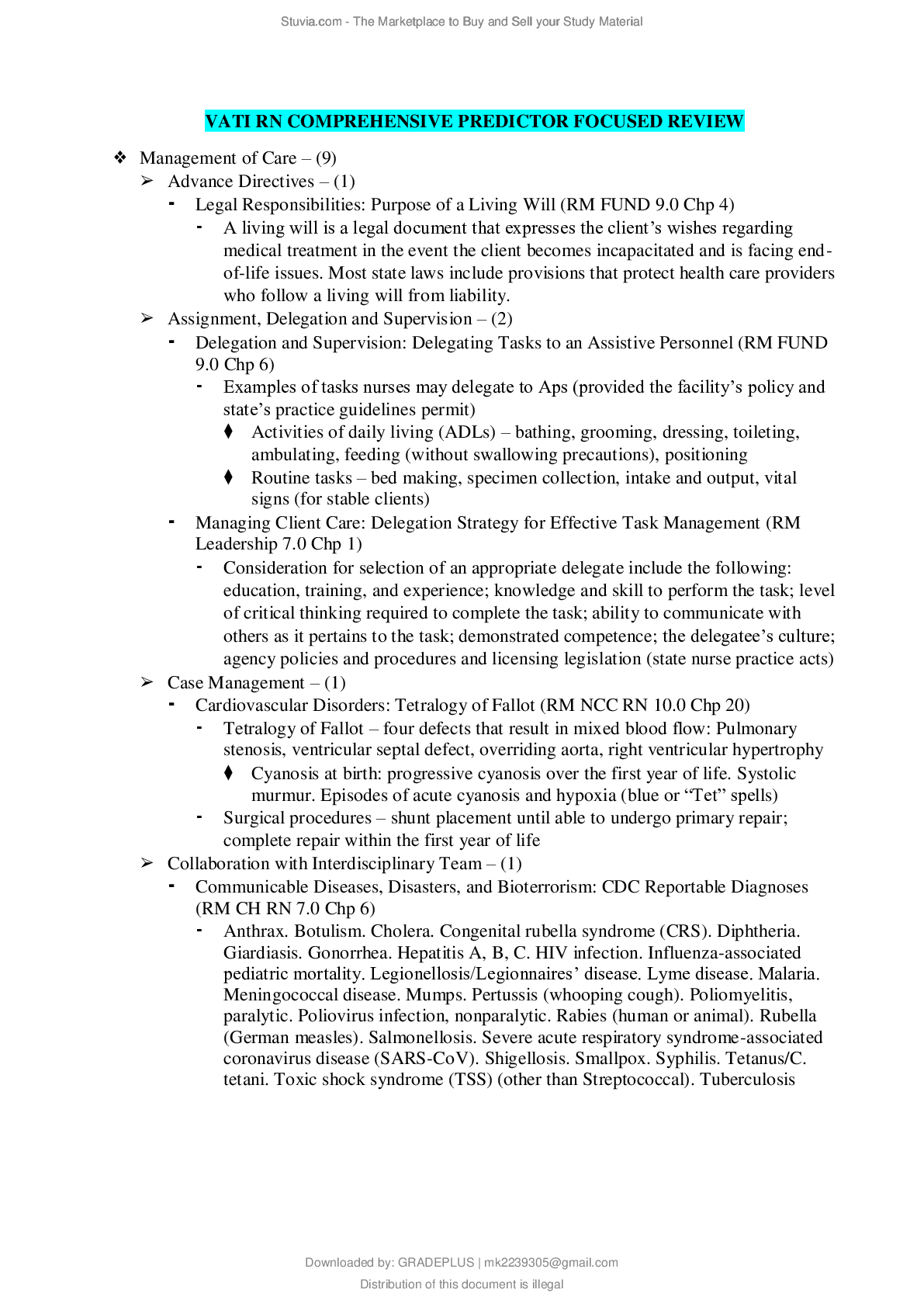

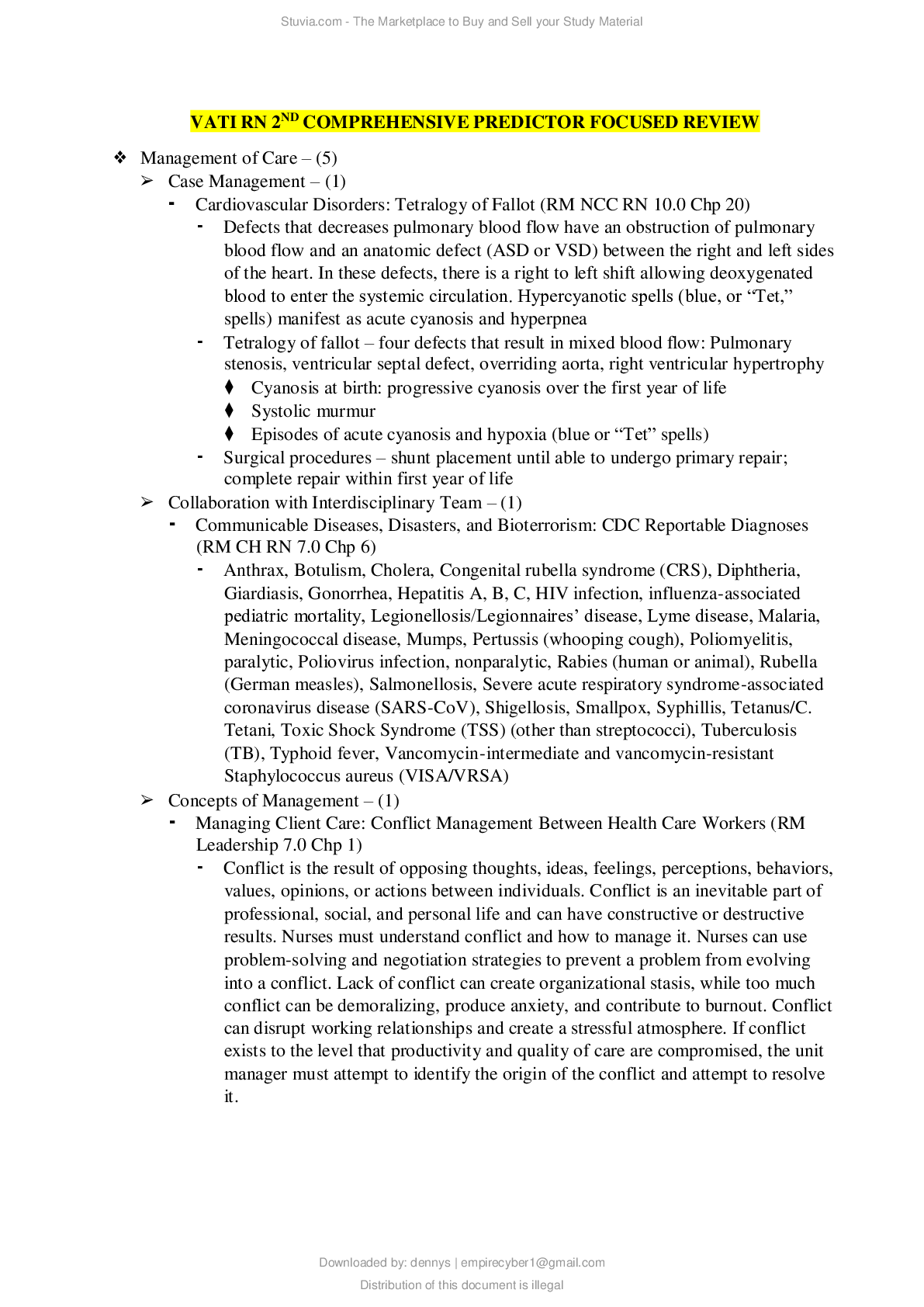

_removed.png)
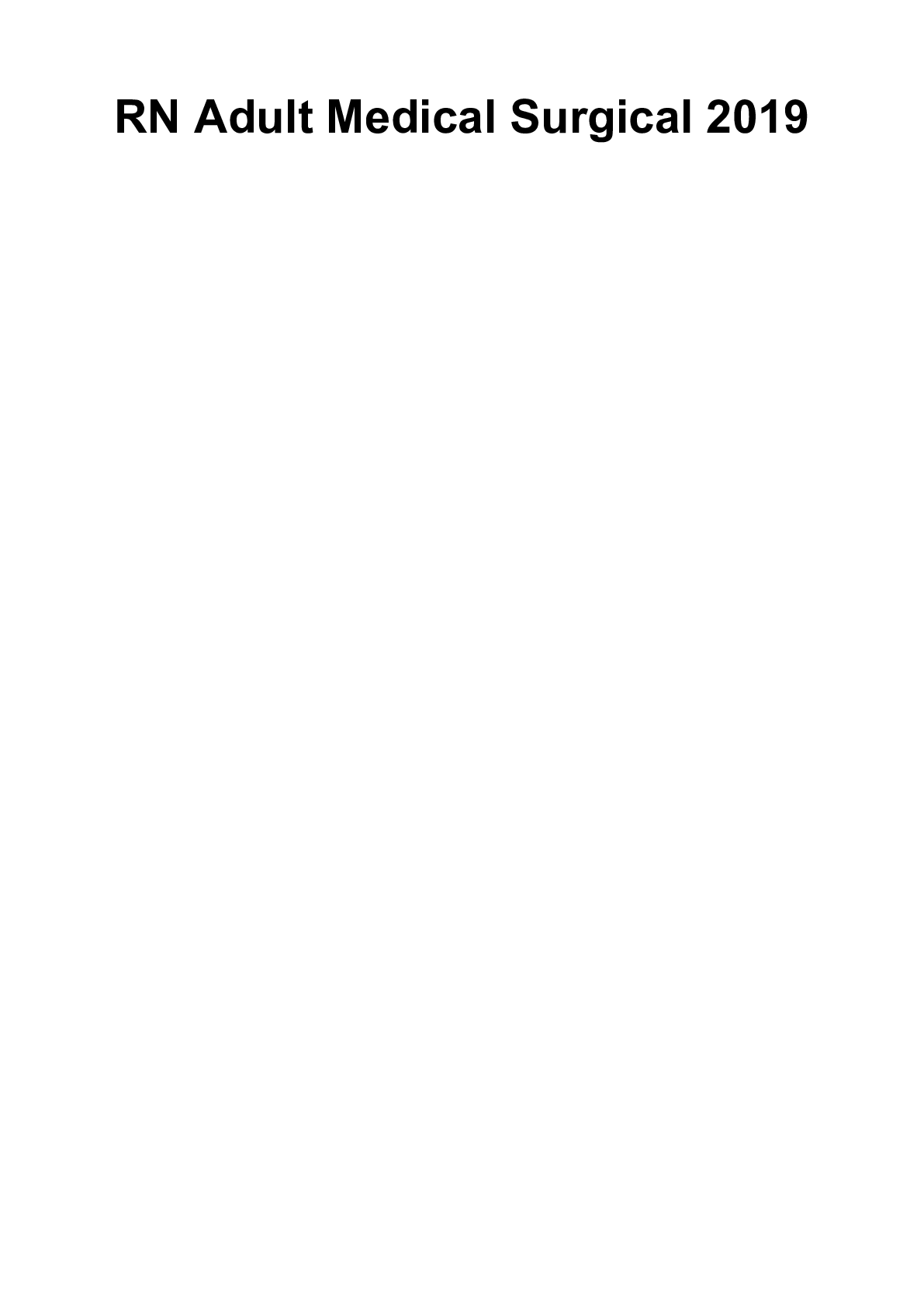
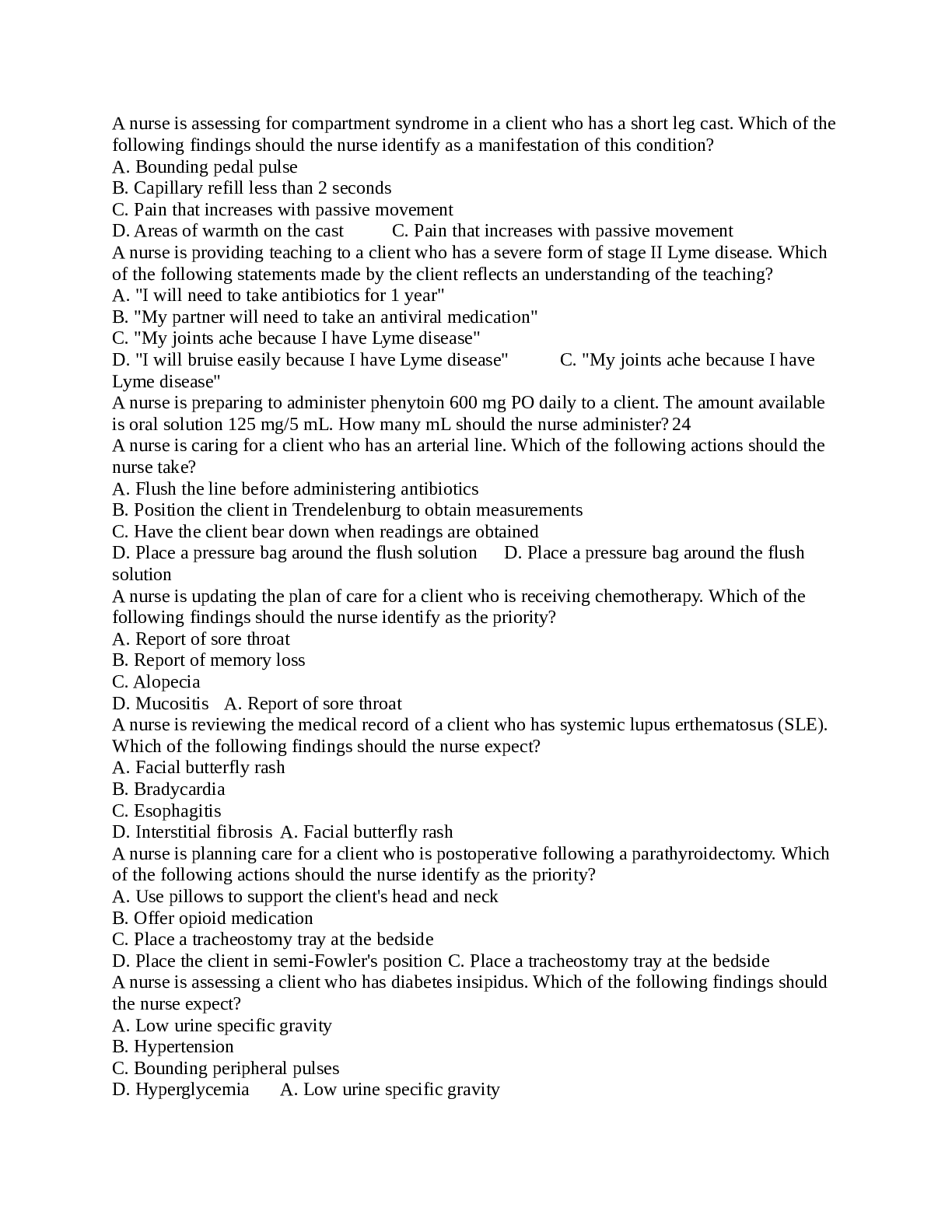
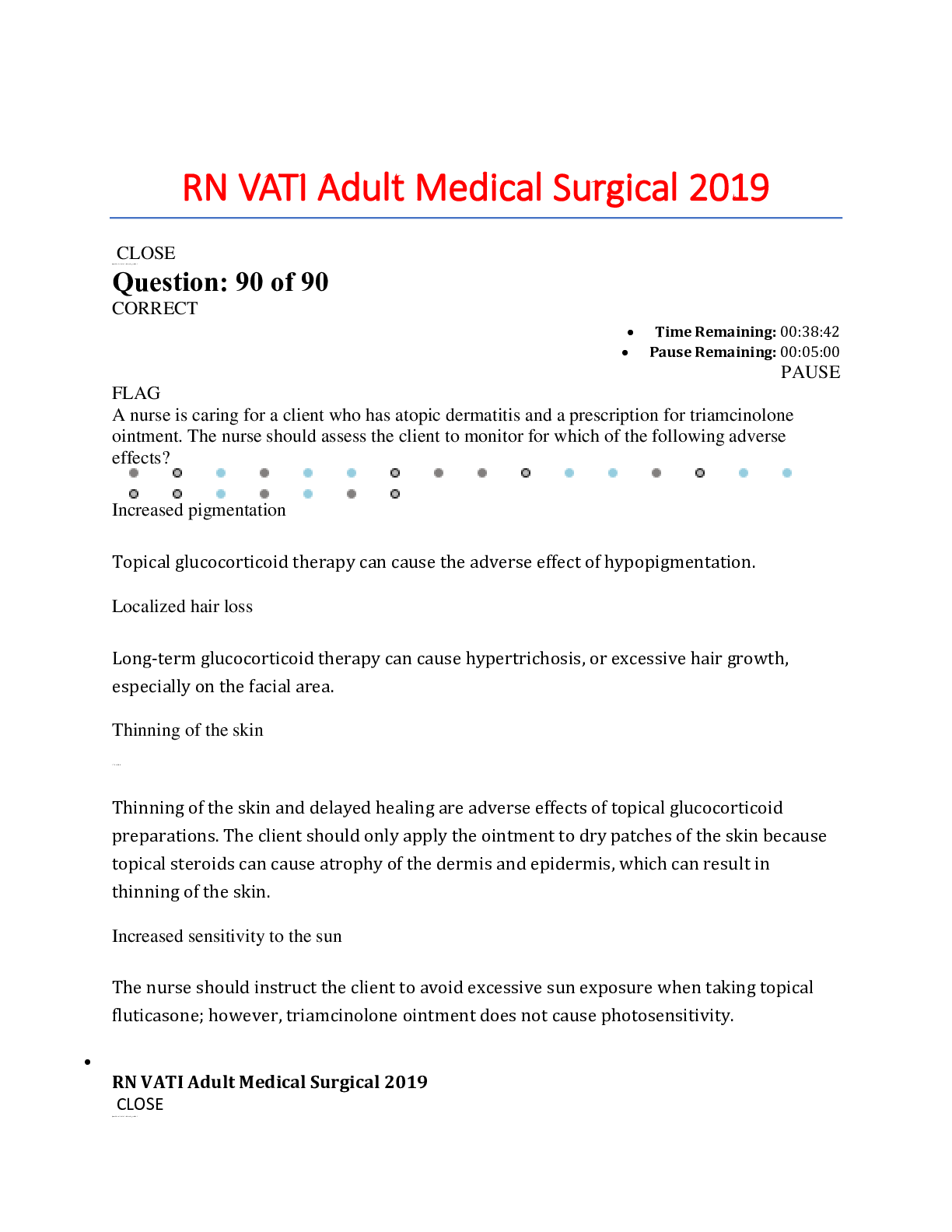
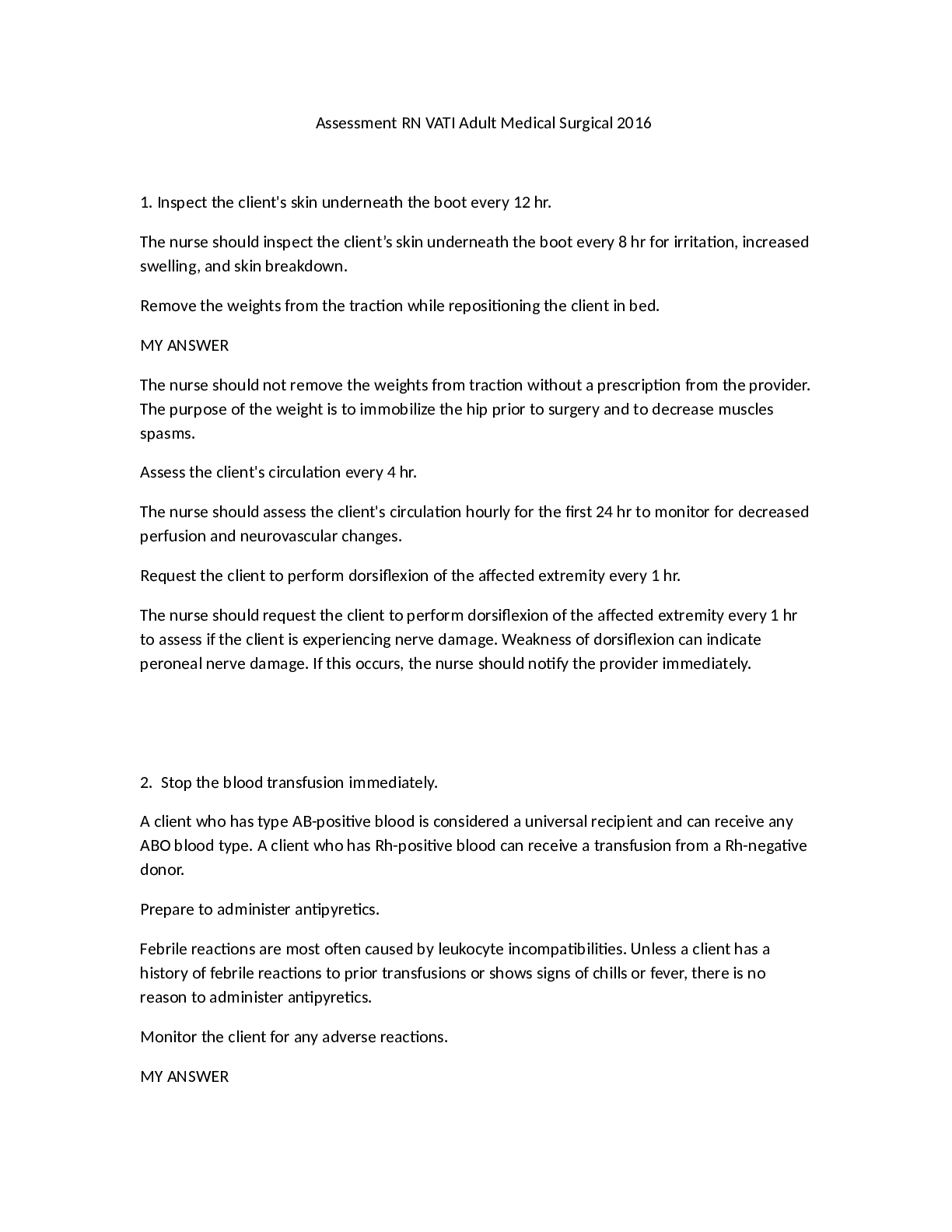
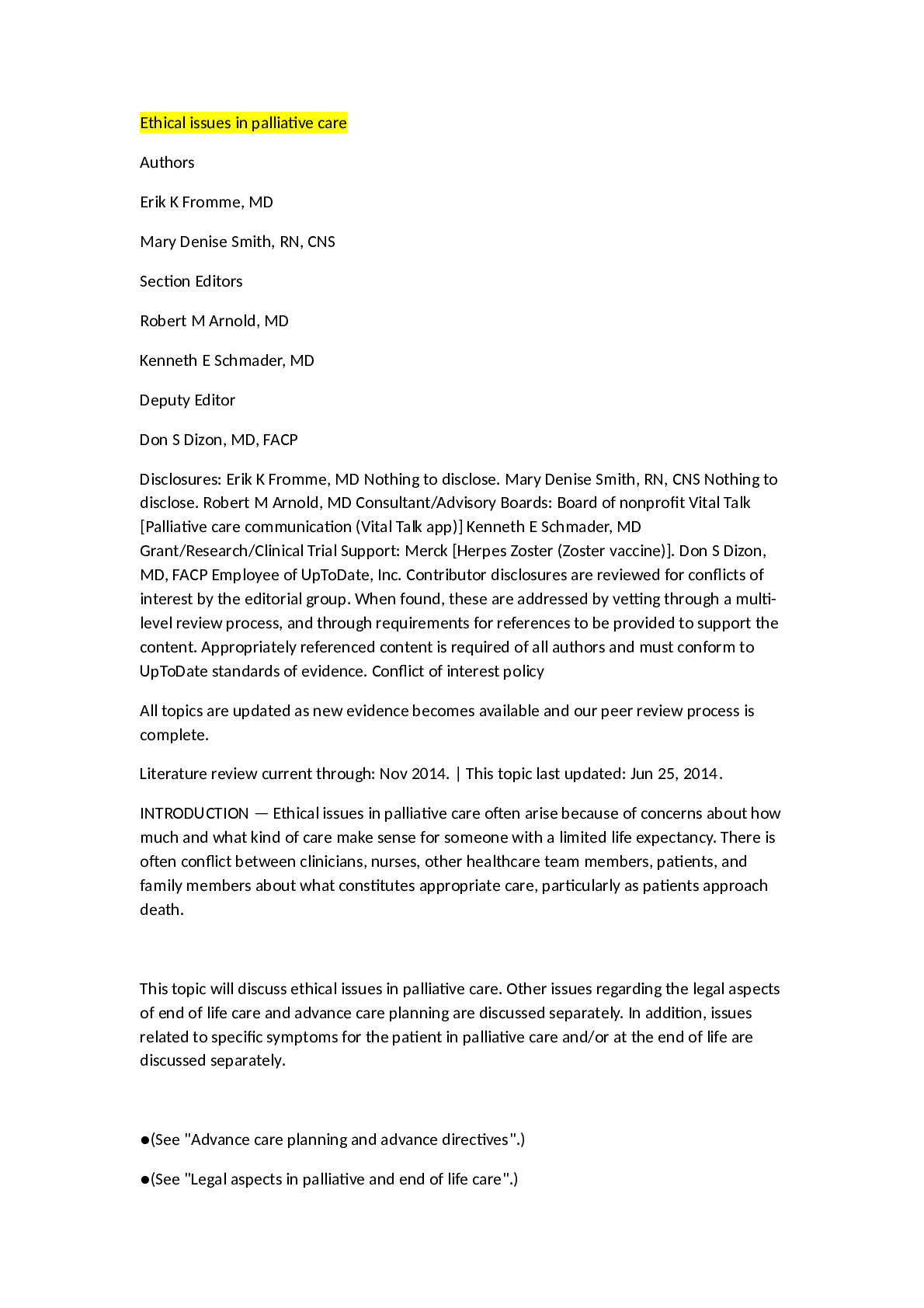
 Verified Questions and Answers Exam Guide.png)
